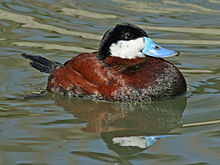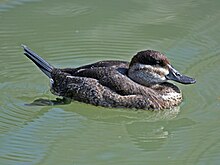|
Ruddy duck
 The ruddy duck (Oxyura jamaicensis) is one duck of six species within the stiff-tailed ducks (Oxyura) genus. They occupy heavily vegetated habitats in North and South America as well as the British Isles, France and Spain. Ruddy ducks were introduced to the United Kingdom in the 1940s where they have since established a growing population. Outside the Americas, ruddy ducks are considered a highly invasive species, prompting many countries to initiate culling projects to eradicate them from the native ecosystem. The genus name is derived from Ancient Greek oxus, "sharp", and oura, "tail", and jamaicensis is "from Jamaica". Ruddy ducks have also been nicknamed "butterball", a term used to describe an individual who is somewhat fat, due to their short and stout stature making activities like flying and walking upright awkward.[2] TaxonomyThe ruddy duck was formally described in 1789 by the German naturalist Johann Friedrich Gmelin in his revised and expanded edition of Carl Linnaeus's Systema Naturae. He placed it with the other ducks, geese and swans in the genus Anas and coined the binomial name Anas jamaicensis.[3] Gmelin based his description on the "Jamaica shoveler" that had been described in 1785 by the English ornithologist John Latham from a specimen that he had received from Jamaica.[4] The ruddy duck is now placed with five other species in the genus Oxyura that was introduced in 1828 by the French naturalist Charles Lucien Bonaparte.[5][6] The genus name is derived from Ancient Greek oxus, meaning "sharp", and oura meaning "tail". The specific epithet jamaicensis means "from Jamaica".[7] The Andean duck was formerly considered to be conspecific with the ruddy duck but with the two species split, the ruddy duck is monotypic: no subspecies are recognised.[6] DescriptionThese are small, compact ducks with stout, scoop-shaped bills, and long, stiff tails they often hold cocked upward. They have slightly peaked heads and fairly short, thick necks. Male ruddy ducks have blackish caps that contrast with bright white cheeks. In summer, they have rich chestnut bodies with bright blue bills. In winter, they are dull gray-brown above and paler below with dull gray bills. Females and first-year males are brownish, somewhat like winter males but with a blurry stripe across the pale cheek patch. In flight, ruddy ducks show solidly dark tops of the wings.[8] On average, females are smaller and weigh less than males. They have a short and stout scoop-shaped bill designed for underwater foraging. With their short stature, they are known to be great swimmers whilst finding taking flight a much more laboured task.[9] In comparison to other ducks, ruddy ducks rarely fly but when they do, it is done with a very fast wingbeat and closely over the water. [10] An interesting physical feature found within this taxonomy of duck is the trachea and stiff-tails’s inflatable air sacs and esophagi which are used in displays. [11] The tail of the ruddy duck is commonly seen held upwards. [12]
VocalizationsBoth male and female ruddy ducks are not known to be very vocal most of the year, though they do become more vocal when courting and raising young.[11] Males are known to produce short "aa-anh" calls and other noises in short bursts. Female ruddy ducks have a much higher pitched call, often having a "raanh" sound when communicating with their brood, squeaks when chased by males, and hisses and nasal sounds towards intruders.[2] Behaviour and ecologyBreeding and habits Unlike other migratory anatine courtship where partnerships occur in wintering grounds, ruddy ducks often begin courtship on the breeding ground. Both male and female ruddy ducks have been observed interacting aggressively with each other but despite aggression, pairs can be seen loafing next to each other minutes later.[15] Their breeding habitat is marshy lakes and ponds. Both male and females are not known to be very vocal with quacks, though males are known to produce a distinct drumming sound by beating their lower mandible on their breast. This drumming beat is done hard enough that often swirls of bubbles will appear in the water. This display is known as "bubbling".[10] In an aggressive response, the male faces his rival while performing bubbling. In courting, a bubbling male orientates his body laterally to the female. In a group of courting birds of more than one male, the males typically display rapidly alternating forms of bubbling in accordance with constantly and suddenly changing aggressive and sexual responses.[15] In courting gestures females mostly respond to the male’s advances.[10] They nest in dense marsh vegetation near water. The female builds the nest out of grass, locating it in tall vegetation to hide it from predators. A typical brood contains 5 to 15 ducklings.[16] Pairs form each year. Though ruddy ducks can have large broods, the male normally takes no part in rearing.[15] The female will incubate the eggs for 23–26 days whilst being protected by her mate.[2] After the young hatch, it only takes about a month or two until they are fully ready to fly but as a result of the young being independent very quickly, they often stray from the rest of the brood. Females will care for her young but never for the entire period of the fledgling.[10] Female ruddy ducks have been observed acting in brood parasitism. There hasn’t been a clear factor that influences females to lay their eggs in other nests. Though it was observed that parasitic eggs were more likely to be male than female hatchlings.[15] Though some suspect that the parasitic laying is directly tied to the lack of attunement between the female ruddy duck and the environmental cues.[17] They are migratory and winter in coastal bays and unfrozen lakes and ponds. FeedingRuddy ducks mainly feed on a large amount of plant matter like seeds and roots as well as aquatic insects and crustaceans. A large portion of the animal matter consumed is larvae and pupae.[9][18] During the winter, they often consume a higher amount of animal food. The food foraged is done underwater, an activity that the ruddy duck excels at. They forage by straining food from the surface of the substrate, moving their bills side to side whilst opening and closing their mandibles. This allows their food to stay caught in between their bill whilst the substrate is filtered out. Due to all foraging occurring with substrate clouding the water, the way ruddy ducks select their prey is not through visuals. Instead, ruddy ducks use tactile location of the larvae and pupae to forage.[19] Ruddy ducks can also feed on small molluscs and crustaceans like bivalves and amphipods. They are able to find these organisms in moving waters by using the tip of their bill as it has many sensory endings which direct the duck towards their food. The slight crooked shape of their mandible also allows them to efficiently tear at plant matter underwater.[10] When searching for randomly placed food patches, Ruddy Ducks sampled previously profitable sites before investigating other areas more frequently than would be expected by chance. Revisiting previously profitable foraging sites may be important when exploiting a patchy food resource with prey densities that are likely to be quickly replenished after having been exploited.[20] Invasive species/CullAs a result of escapes from wildfowl collections in the late 1950s, they became established in Great Britain, from where they spread into Europe. This duck's aggressive courting behavior and willingness to interbreed with the endangered native white-headed duck (Oxyura leucocephala), of southern Europe, caused concern amongst Spanish conservationists. Due to this, a controversial scheme to extirpate the ruddy duck as a British breeding species started; there have also been culling attempts in other European countries.[21] By March 2012 a culling program in the UK, supported by the RSPB, had killed 6,500, at a cost of £5m (£769 per bird).[22] In 2003 the BBC had reported the cost of killing each bird at £915.[21] In 2012 Lee Evans, founder of the British Birding Association, claimed "The cull cannot succeed now. There are hundreds of ruddy ducks on the continent which will not be killed so the birds will continue to breed. There's never been any proof, anyway, that the British population has ever interbred with the Spanish ducks".[22] By early 2014, the cull had reduced the British population to about 20–100, down from a peak of about 5,500 in 2000.[23] According to Animal Aid, in the UK the cost of hunting down the last few ruddy ducks was £3,000 per bird. They advised "If you see one, don’t tell anyone. Even bird groups will tell the authorities and those birds may be killed".[24] In Europe, the ruddy duck is included since 2016 in the list of Invasive Alien Species of Union concern (the Union list).[25] That implies the species cannot be imported, bred, transported, commercialized, or intentionally released into the environment in the whole of the European Union.[26] References
External linksWikimedia Commons has media related to Oxyura jamaicensis.
|
||||||||||||||||||||||||||||||||||||||||||||||||||||||||||||




